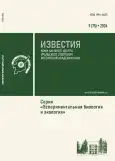Роль светозащитных пигментов в стрессовой устойчивости лишайников
- Авторы: Минибаева Ф.В.1, Бекетт Р.П.1,2
-
Учреждения:
- Казанский институт биохимии и биофизики ФИЦ КазНЦ РАН
- Университет КваЗулу-Натал
- Выпуск: № 9 (2024)
- Страницы: 13-17
- Раздел: Статьи
- URL: https://journal-vniispk.ru/1994-5655/article/view/278423
- DOI: https://doi.org/10.19110/1994-5655-2024-9-13-17
- ID: 278423
Цитировать
Полный текст
Аннотация
Лишайники синтезируют большое количество вторичных метаболитов, в том числе «лишайниковых веществ». Наличие лишайниковых веществ позволяет лишайникам произрастать в разнообразных, зачастую стрессовых, экологических нишах. Среди вторичных метаболитов лишайников особый интерес вызывают светозащитные пигменты. Темно-коричневый пигмент меланин играет значительную роль в защите лишайников от УФ-Б стресса, однако ключевые драйверы меланизации остаются неизученными. Меланины – гидрофобные гетерогенные полимеры, образованные последовательными реакциями окисления фенольных/индольных предшественников и последующей полимеризации промежуточных фенолов и хинонов. Формирование меланинового слоя на поверхности таллома в ответ на УФ воздействие является одним из ключевых механизмов высокой устойчивости лишайников не только к световому стрессу, но и обезвоживанию. Нами показано, что связывание молекул воды с меланином зависит от активности специфических функциональных групп в структуре этого полимера, элементного состава, присутствия ассоциированных соединений, в том числе полисахаридов, и ультраструктуры меланиновых частиц. Антрахинон париетин является доминирующим кортикальным пигментом лишайников Caloplaca и Xanthoria из семейства Teloschistaceae. Наряду с обеспечением защиты таллома от высокой фотосинтетически активной радиации и УФ излучения, париетин обладает антиоксидантными свойствами, способствует защите лишайников от кадмиевой токсичности, обезвоживания. Париетин обеспечивает защиту талломов лишайников от абиотических стрессов благодаря поддержанию стабильности мембран, антиоксидантной защите, формированию структурного барьера и сохранению воды в кортексе талломов лишайника. Уникальные свойства пигментов лишайников делают эти естественные полимеры перспективными объектами для фундаментальных и прикладных исследований, в частности, в медицине, биотехнологии и «зеленой электронике».
Ключевые слова
Об авторах
Фарида Вилевна Минибаева
Казанский институт биохимии и биофизики ФИЦ КазНЦ РАН
Автор, ответственный за переписку.
Email: fminibayeva@gmail.com
ORCID iD: 0000-0003-0827-181X
доктор биологических наук, заведующий лабораторией окислительно-восстановительного метаболизма
Россия, 420111, г. Казань, ул. Лобачевского, д. 2/31Ричард Питер Бекетт
Казанский институт биохимии и биофизики ФИЦ КазНЦ РАН; Университет КваЗулу-Натал
Email: rpbeckett@gmail.com
ORCID iD: 0000-0002-0530-4244
профессор, ведущий научный сотрудник лаборатории окислительно-восстановительного метаболизма Казанского института биохимии и биофизики ФИЦ КазНЦ РАН; Школа наук о жизни, Университет КваЗулу-Натал
Россия, 420111, г. Казань, ул. Лобачевского, д. 2/31; г. Скоттсвилл, Южно-Африканская РеспубликаСписок литературы
- Gill, H. Lichen fungal secondary metabolites: progress in the genomic era toward ecological roles in the interaction / H. Gill, J. L. Sorensen, J. Collemare. – Springer International Publishing : Plant Relationships: Fungal-Plant Interactions, 2022. – P. 185–208.
- Goga, M. Lichen metabolites: an overview of some secondary metabolites and their biological potential / M. Goga, J. Elečko, M. Marcinčinová [et al.]. – Springer International Publishing : Reference Series in Phytochemistry, 2020. – P. 175–209.
- Beckett, R. P. Improved photoprotection in melanized lichens is a result of fungal solar radiation screening rather than photobiont acclimation / R. P. Beckett, K. A. Solhaug, Y. Gauslaa, F. Minibayeva // The Lichenologist. – 2019. – Vol. 51. – № 5. – P. 483–491.
- Leksin, I. Ultraviolet-induced melanisation in lichens: physiological traits and transcriptome profile / I. Leksin, M. Shelyakin, I. Zakhozhiy [et al.] // Physiologia Plantarum. – 2024. – Vol. 176. – № 5. – P. e14512.
- Minibayeva, F. V. Protective properties of melanin from lichen Lobaria pulmonaria (L.) Hoffm. in models of oxidative stress in skeletal muscle / F. V. Minibayeva, A. E. Rassabina, G. F. Zakirjanova [et al.] // Fitoterapia. – 2024. – Vol. 177. – P. 106127.
- Rassabina, A. E. Melanin from the lichens Cetraria islandica and Pseudevernia furfuracea: structural features and physicochemical properties / A. E. Rassabina, O. P. Gurjanov, R. P. Beckett, F. V. Minibayeva // Biochemistry. – 2020. – Vol. 85. – P. 623–628.
- Dogan, S. A. Redox signaling and stress in inherited myopathies / S. A. Dogan, G. Giacchin, E. Zito, C. Viscomi // Antioxidants & Redox Signaling. – 2022. – Vol. 37. – № 4–6. – P. 301–323.
- Korytowski, W. Antioxidant action of neuromelanin: the mechanism of inhibitory effect on lipid peroxidation / W. Korytowski, T. Sarna, M. Zarba // Archives of Biochemistry and Biophysics. – 1995. – Vol. 319. – № 1. – P. 142–148.
- Mokrzynski, K. Photoreactivity and phototoxicity of experimentally photodegraded hair melanosomes from individuals of different skin phototypes / K. Mokrzynski, M. Sarna, T. Sarna // Journal of Photochemistry and Photobiology B: Biology. – 2023. – Vol. 243. – P. 112704.
- Kalinowska, R. Parietin in the tolerant lichen Xanthoria parietina (L.) Th. Fr. increases protection of Trebouxia photobionts from cadmium excess / R. Kalinowska, M. Bačkor, B. Pawlik-Skowrońska // Ecological Indicators. – 2015. – Vol. 58. – P. 132–138.
- Daminova, A. G. The roles of the anthraquinone parietin in the tolerance to desiccation of the lichen Xanthoria parietina: physiology and anatomy of the pale and bright-orange thalli / A. G. Daminova, I. Y. Leksin, V. R. Khabibrakhmanova [et al.] // International Journal of Molecular Sciences. – 2024. – Vol. 25. – № 13. – P. 7067.
- Kohlhardt-Floehr, C. Prooxidant and antioxidant behaviour of usnic acid from lichens under UVB-light irradiation-studies on human cells / C. Kohlhardt-Floehr, F. Boehm, S. Troppens [et al.] // Journal of Photochemistry and Photobiology B: Biology. – 2010. – Vol. 101. – № 1. – P. 97–102.
Дополнительные файлы





